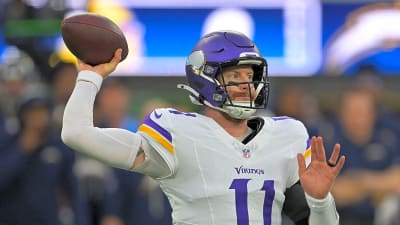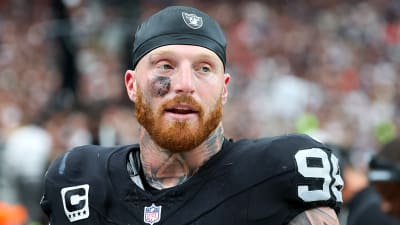- Home
- Quizzes
- My Quiz Activity
- Newsletters
- MY FAVORITES
- Add Sports/Teams
- SPORTS
-
NFL
- NFL Home
- Arizona Cardinals
- Atlanta Falcons
- Baltimore Ravens
- Buffalo Bills
- Carolina Panthers
- Chicago Bears
- Cincinnati Bengals
- Cleveland Browns
- Dallas Cowboys
- Denver Broncos
- Detroit Lions
- Green Bay Packers
- Houston Texans
- Indianapolis Colts
- Jacksonville Jaguars
- Kansas City Chiefs
- Las Vegas Raiders
- Los Angeles Chargers
- Los Angeles Rams
- Miami Dolphins
- Minnesota Vikings
- New England Patriots
- New Orleans Saints
- New York Jets
- New York Giants
- Philadelphia Eagles
- Pittsburgh Steelers
- San Francisco 49ers
- Seattle Seahawks
- Tampa Bay Buccaneers
- Tennessee Titans
- Washington Commanders
-
MLB
- MLB Home
- Athletics
- Arizona Diamondbacks
- Atlanta Braves
- Baltimore Orioles
- Boston Red Sox
- Chicago White Sox
- Chicago Cubs
- Cincinnati Reds
- Cleveland Guardians
- Colorado Rockies
- Detroit Tigers
- Houston Astros
- Kansas City Royals
- Los Angeles Angels
- Los Angeles Dodgers
- Miami Marlins
- Milwaukee Brewers
- Minnesota Twins
- New York Yankees
- New York Mets
- Philadelphia Phillies
- Pittsburgh Pirates
- San Diego Padres
- San Francisco Giants
- Seattle Mariners
- St. Louis Cardinals
- Tampa Bay Rays
- Texas Rangers
- Toronto Blue Jays
- Washington Nationals
-
NBA
- NBA Home
- Atlanta Hawks
- Boston Celtics
- Brooklyn Nets
- Charlotte Hornets
- Chicago Bulls
- Cleveland Cavaliers
- Dallas Mavericks
- Denver Nuggets
- Detroit Pistons
- Golden State Warriors
- Houston Rockets
- Indiana Pacers
- Los Angeles Clippers
- Los Angeles Lakers
- Memphis Grizzlies
- Miami Heat
- Milwaukee Bucks
- Minnesota Timberwolves
- New Orleans Pelicans
- New York Knicks
- Oklahoma City Thunder
- Orlando Magic
- Philadelphia 76ers
- Phoenix Suns
- Portland Trail Blazers
- Sacramento Kings
- San Antonio Spurs
- Toronto Raptors
- Utah Jazz
- Washington Wizards
-
NHL
- NHL Home
- Anaheim Ducks
- Boston Bruins
- Buffalo Sabres
- Calgary Flames
- Carolina Hurricanes
- Chicago Blackhawks
- Colorado Avalanche
- Columbus Blue Jackets
- Dallas Stars
- Detroit Red Wings
- Edmonton Oilers
- Florida Panthers
- Los Angeles Kings
- Minnesota Wild
- Montreal Canadiens
- Nashville Predators
- New Jersey Devils
- New York Islanders
- New York Rangers
- Ottawa Senators
- Philadelphia Flyers
- Pittsburgh Penguins
- San Jose Sharks
- Seattle Kraken
- St. Louis Blues
- Tampa Bay Lightning
- Toronto Maple Leafs
- Utah Mammoth
- Vancouver Canucks
- Vegas Golden Knights
- Washington Capitals
- Winnipeg Jets
- NCAAF
- NCAAM
- Olympics
- Boxing
- Entertainment
- Lifestyle
- Golf
- MMA
- Soccer
- Tennis
- Wrestling
- Sports Betting
- More Sports
- RESOURCES
- My Account
- YB on Facebook
- YB on Twitter
- YB on Flipboard
- Contact Us
- Privacy Policy
- Terms of Service
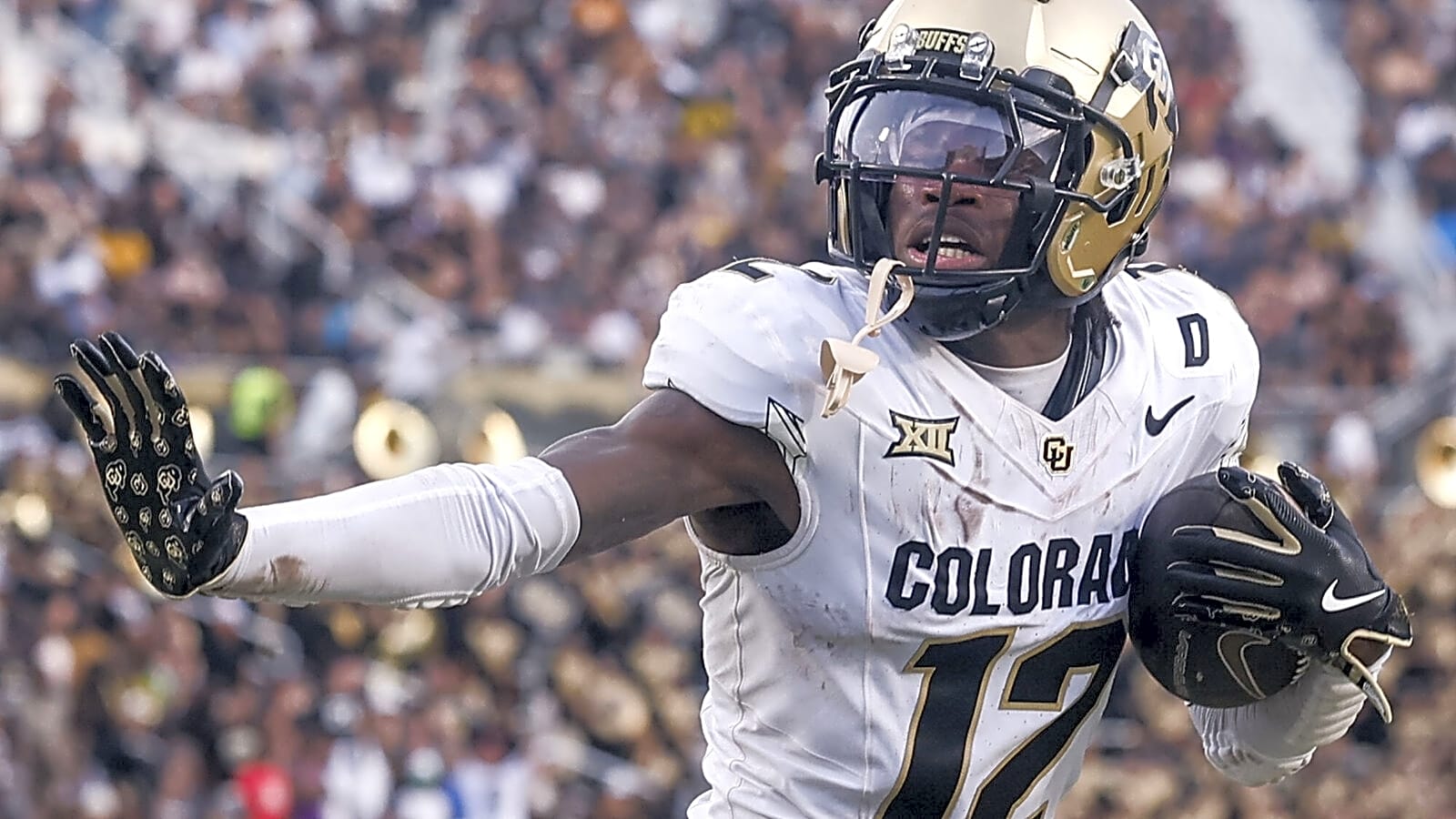
The 25 greatest college football players from the 21st century
We have been blessed to have watched so many talented college football players over the last 25 years. With the rise of more Air Raid offenses, we've been able to see skill players break out and show us things we've never seen before, while defensive players get bigger, faster and stronger. With the NFL adopting more of the college-style offenses, these players feel more emboldened to lean into their unique skills since it does prepare them for the next level.
Players have endured major changes in the sport. Schools changing conferences, longer postseasons, the transfer portal, and NIL have created a new way players can not only find the right system to showcase their talents, but a pathway now exists to maximize their time in the college ranks.
It is a difficult task to pick the top 25 players over the first quarter of the 21st century, but one we were willing to try. Here you go: the best 25 players over the first 25 years of the 2000s.
Will Anderson Jr., LB, Alabama
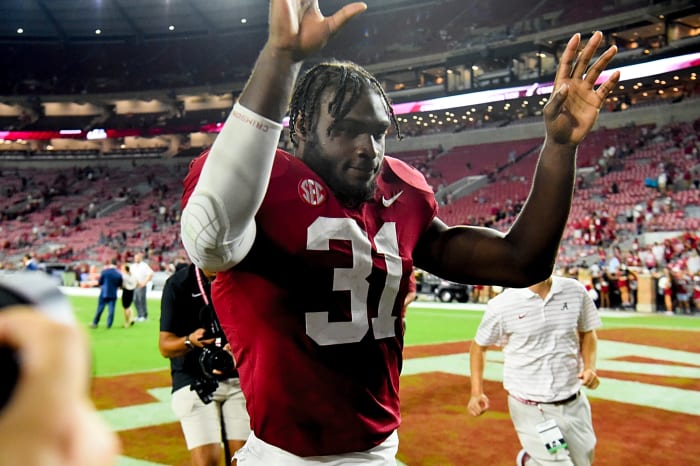
Anderson, like the other defensive players on this list, was simply dominant. He won the Bronko Nagurski Award twice, the Chuck Bednarik Award, the Lombardi Award, was a two-time SEC Defensive Player of the Year, a two-time unanimous first team All-American, and led the nation in sacks as a sophomore. That same season, he had 11 games in which he recorded at least two tackles for loss.
Justin Blackmon, WR, Oklahoma State
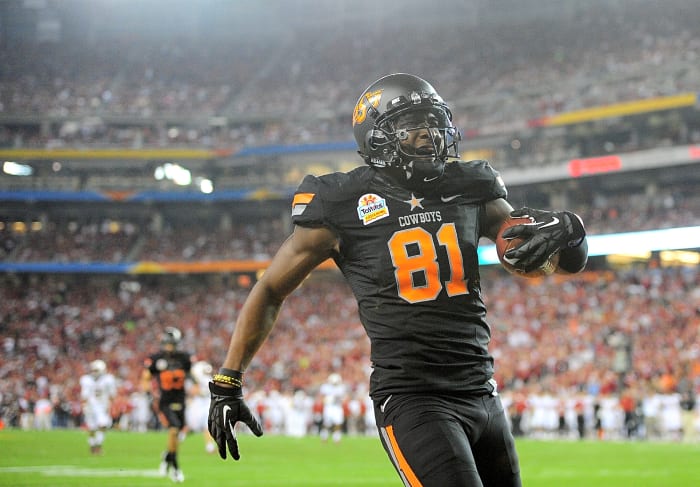
While legal issues and off-field problems ended his NFL career after just 20 games, there is no debating that Justin Blackmon's college career was sparkling. After redshirting his true freshman season and catching just 20 passes in his first year, he blew up as a sophomore. In 2010, Blackmon caught 111 passes for 1,782 yards and 22 total touchdowns during the Cowboys' 11-2 season. He'd follow it up with 122 receptions, 1,522 yards and 18 TDs as a junior. If not for a missed field goal at the end of regulation against Iowa State (the Cowboys would lose in overtime), Oklahoma State would have been undefeated and likely playing in the BCS championship game against LSU.
Joe Burrow, QB, LSU
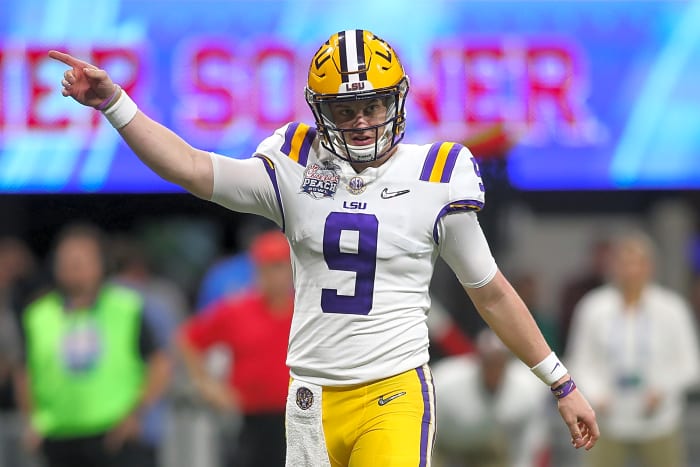
Joe Burrow and LSU's dominant 2019 season will be remembered for a long, long time and is a prime example of how the transfer portal should work. Burrow threw just 39 passes in his first two seasons with the Ohio State Buckeyes. He then transferred to LSU and everything started to click late in his junior season, which ended with a 394-yard/4 TD game in a Fiesta Bowl win over UCF. Still, no one could see his senior season coming.
Burrow completed an insane 402 of his 527 passes (76%) for 5,671 yards and 60 touchdowns! And he threw just six picks. In the two games of the College Football Playoff, Burrow completed 60 of 88 (68%) for 956 yards and 12 TDs (he also rushed for a touchdown in each game). The 2019 LSU Tigers were sensational and in the mix as the best team in college football history. Burrow, the top pick in the 2020 NFL Draft, was a major reason for their success.
Reggie Bush, RB, USC

Reggie Bush may be the most celebrated player of the 2000s. He was lethal as a runner, receiver and returner, and was a cultural icon for college football fans of the first decade of the new millennium. He won two national championships and played for a third, won the Heisman Trophy as a junior, and finished 5th in voting as a sophomore. In that Heisman season, he rushed for 1,740 yards, received for 478 yards, had 493 kick return yards and 179 punt return yards. He scored 19 touchdowns (16 rush, 2 receiving, 1 return) and typically came up huge in the big moments. Whether it was the Bush Push vs Notre Dame, or his unreal performance against Fresno State in 2005 (294 rush yds; 68 rec yds; 151 return yds) or his follow-up performance pummeling UCLA (260 more rush yards), Bush was electric.
He also became the poster child for the evolution of college athletics off the field. After improper benefits were discovered, Bush was stripped of his Heisman Trophy award. Due to the changes in attitudes regarding NIL and revenue sharing in college sports, Bush had his Heisman reinstated in 2024.
Larry Fitzgerald, WR, Pitt

Every once in a while, you see a receiver in college and instantly know he's going to be one of the greats. Larry Fitzgerald was certainly one of those rare talents who felt like college was just too small of a stage for him. After a year at Valley Forge Military Academy, Fitzgerald burst on the scene as a freshman at Pitt. In his second career game, he caught 10 passes for 103 yards in a loss to Texas A&M. He'd catch his first TD pass (well, first two) two weeks later against Toledo, where he totaled 121 receiving yards. From that game on, Fitzgerald would catch a touchdown in 20 of his next 21 games -- including a streak of 18 straight. As a sophomore, he caught 22 TDs and had 10 games of at least 100 yards receiving.
He petitioned to be eligible for the 2004 NFL Draft, and became one of the greatest receivers in NFL history. His poise, attention to detail, and techniques were evident even in his two seasons at Pitt.
Travis Hunter, DB/WR, Colorado
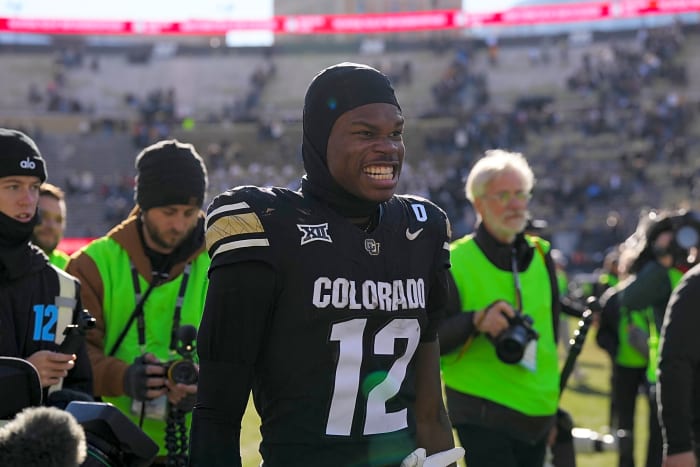
This isn't recency bias -- Travis Hunter is clearly one of the greatest players of the last few decades.
He carved his own path by becoming one of the top high school players in the nation yet chose to go to college at FCS Jackson State University. He would follow head coach Deion Sanders to Colorado where he continued his ironman performance. In 2024, he won the Heisman Trophy after catching 96 passes for 1,258 yards and 15 TDs while also picking off 4 passes. He won the Biletnikoff award as the top receiver and the Bednarik award for the best defensive player. He just didn't play on both sides of the ball -- he was the best player on either side. He averaged 115 snaps a game as a sophomore and 114 snaps as a junior.
Lamar Jackson, QB, Louisville

Lamar Jackson was a cheat code at Louisville. After a rough start to his freshman season (his first pass was picked off), he kept improving and would be the Music City Bowl MVP after rushing for 226 yards (a Music City Bowl record). That was the catalyst for a special sophomore year where Jackson threw for 3,543 yards, rushed for 1,572 yards, and totaled 51 touchdowns. In the first game of the season, Jackson accounted for eight TDs -- all in the first half! The Cardinals would ascend to as high as No. 3 in the rankings, but a three-game losing streak at the end of the year knocked them out of national championship contention.
Still, Jackson was the Heisman winner in 2016, and you could argue that his following season was even better. While the Cardinals weren't as good that season, Jackson improved on his completion percentage, passing yards and rushing yards. He was ACC Player of the Year twice and finished 3rd in Heisman voting in 2017. After three years at Louisville, Jackson threw for over 9,000 yards and 69 touchdowns while rushing for 4,132 yards and 50 TDs.
Andrew Luck, QB, Stanford
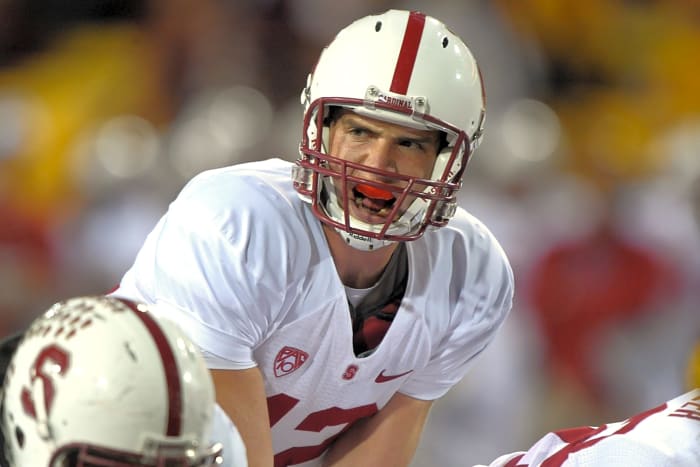
There will be other quarterbacks with better stats, Heisman Trophies or national championships, but none of the QBs will be able to say they were the entire program while they were there. Luck did have great stats (9,430 passing yards, 82 TDs, nearly 1,000 yards rushing and 7 rush TDs), but it's how he turned a program around when he got there.
Stanford had seven straight losing seasons before playing his first game for the Cardinal (a combined 25-55 record). In his three seasons as a starter, the Cardinal went 31-8 and reached two BCS bowls. He also finished second in the Heisman voting twice (losing to Cam Newton and Robert Griffin III).
Khalil Mack, LB, Buffalo

After just one year of playing football in high school, Khalil Mack settled in at Buffalo where he would sit for a season before finding his stride. Wearing the number 46 for motivation (his EA Sports NCAA Football 11 rating was 46), he hit the ground (and opponents) running when he got his chance to shine. Over four seasons with the Bulls he would pile up 28.5 sacks, 327 tackles, 4 interceptions and NCAA records with 16 forced fumbles and 75 tackles for loss.
You might say "sure, but he did that in the MAC", but his signature collegiate game was against Ohio State in Columbus. In a 40-20 loss, Mack recorded 9.5 tackles, 2.5 sacks and a pick-six against the Buckeyes, instantly putting scouts on notice.
Tyrann Mathieu, S, LSU

Tyrann "Honey Badger" Mathieu gets on this list due to the impact of his one great season at LSU. He was a backup as a freshman, but still was a nuisance for offenses -- 57 tackles, 9 tackles for loss, 4.5 sacks, 5 forced fumbles and 2 INTs. As a sophomore and now starting, Mathieu maintained his high production and even returned two fumbles for touchdowns. He also became a punt returner, where he took two punts to the house for touchdowns. Due to off field issues, he was dismissed from the team for his entire junior season and would enter the 2013 NFL Draft.
Baker Mayfield, QB, Oklahoma

After an uneven freshman year at Texas Tech, Mayfield transferred to Oklahoma and launched one of the best college careers of the 2000s. In three years with the Sooners, he completed nearly 70% of his passes for 12,292 yards, 119 TDs and 21 interceptions. He finished in the top four in Heisman voting all three seasons and won the award as a senior in 2017. That Heisman season, he accounted for 49 touchdowns -- including five rushing and one receiving. Mayfield would become the top overall pick in the NFL Draft and the first of three Heisman winners coached by Lincoln RIley.
Christian McCaffrey, RB, Stanford

Christian McCaffrey was a Swiss army knife of sorts for the Stanford Cardinal. He was a running back by name (3,922 yards, 21 TDs) but was also a force in the passing game (99 receptions, 1,206 yards, 10 TDs) and as a return specialist. His best season was a sophomore, where he rushed for 2,019 yards, 645 receiving yards and 1,070 kick return yards (he totaled 15 total touchdowns) and finished second to Derrick Henry in Heisman voting. An injury and his decision to opt out of the Cardinal's Sun Bowl game (which was controversial at the time, but has since become the norm) slowed his numbers as a junior, but he still led the Pac-12 in rushing and the nation in all-purpose yards.
Bryant McKinnie, OL, Miami

Usually, offensive linemen don't get much love on lists like this, but McKinnie was special. Well, those early 2000s Miami Hurricanes teams he was part of were also special, but McKinnie anchored one of the greatest offensive lines in recent memory. His speed and skill is simply unfair for a man his size. He began his career as a defensive lineman at Lackawanna College in Scranton, PA, before switching to the other side of the line and transferring to The U. He never allowed a sack at Miami and finished 8th in the Heisman voting in 2001.
Cam Newton, QB, Auburn

Cam Newton pulled off arguably one of the greatest single seasons of the first 25 years of the 21st century ... or maybe the 19th or 20th centuries. After two seasons at Florida that ended with just six games played and a lot of controversy surrounding him, Newton transferred to Auburn where controversy followed but he was able to finally show off his ability.
Newton threw for 2,854 yards, 30 TDs, 7 INTs and rushed for 1,473 yards and 20 touchdowns. He led a very underwhelming Auburn team to a national championship in 2010, won the Heisman Trophy, and became the No. 1 overall pick in the 2011 NFL Draft. While his BCS Championship win over Oregon is his crowning achievement, the "Cam Back" against Alabama in the Iron Bowl a month earlier may have been his finest moment. His combination of size, speed and arm strength was a cheat code and led to one of the greatest seasons of all time.
Julius Peppers, DE, North Carolina

While he won't go down in history as the two-sport star that Bo Jackson or Deion Sanders were, Peppers was one of the great sports athletes of the 21st century. He is still the only athlete to play in a Super Bowl and a Final Four. He ditched basketball at North Carolina after his sophomore season (he scored 21 points and grabbed 10 boards in his final game) and concentrated on football, and became the second overall pick in the NFL Draft.
To have basketball size (6'7, 295 lbs) and skill as a defensive end? Peppers was nearly unstoppable. He led the nation in sacks as a sophomore and as a junior won the Bednarik, Lombardi and Willis awards.
Adrian Peterson, RB, Oklahoma

Peterson had one of the greatest freshman seasons any running back has ever had. He led the nation with 339 carries, and piled up 1,925 yards and 15 touchdowns and played with an injured shoulder late in the season. He began his career with nine straight 100-yard rushing games and burst on the scene with 249 yards rushing (including 161 in the 3rd quarter alone) against Oklahoma State in the 2004 edition of Bedlam. Peterson would finish 2nd to Matt Leinart in Heisman voting that year.
Injuries curtailed his remaining two years in Norman. A foot injury limited Peterson to 11 games, but he tore up Bedlam again (237 yards, 2 TDs) and would rush for over 1,000 yards and 14 touchdowns. He was having a spectacular season as a junior before breaking his collarbone midseason and missing the rest of the regular season. In a move that is now outside the norm, Peterson would return to play in Oklahoma's Fiesta Bowl loss to Boise State where he rushed for 77 yards and a score.
David Pollack, LB/DE, Georgia

David Pollack was a first-team All-American for three seasons (2002-2004) and the SEC Defensive Player of the Year twice. He left Georgia holding several school records that still hold up today and his 36 sacks rank third in NCAA history. His three first-team All-America nods match Herschel Walker for the only Georgia players to accomplish that feat. He is the only player to win the Ted Hendricks Award (for the nation's top defensive end) twice.
Ed Reed, S, Miami
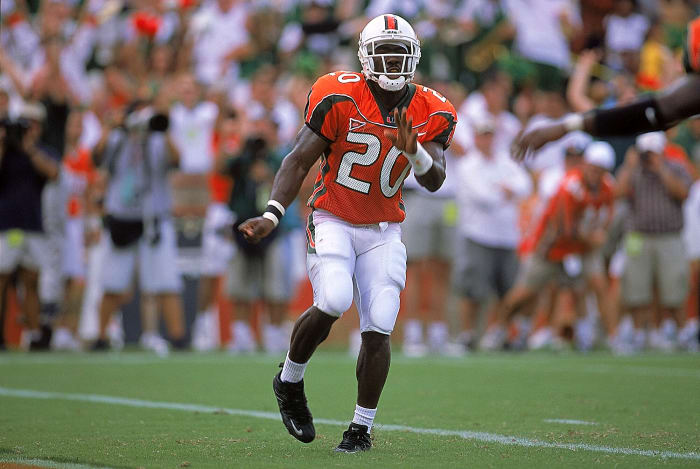
Reed's career spanned the turn of the century, but his final two seasons with Miami were ridiculous. A star on arguably the greatest teams of the 2000s, Reed picked off 17 passes and returned two TDs during the 2000 and 2001 seasons. The Hurricanes defense was lethal in 2001 and his leadership helped carry them to a national championship in 2001. A member of the College Football Hall of Fame and one of the greatest safeties of all time.
DeVonta Smith, WR, Alabama
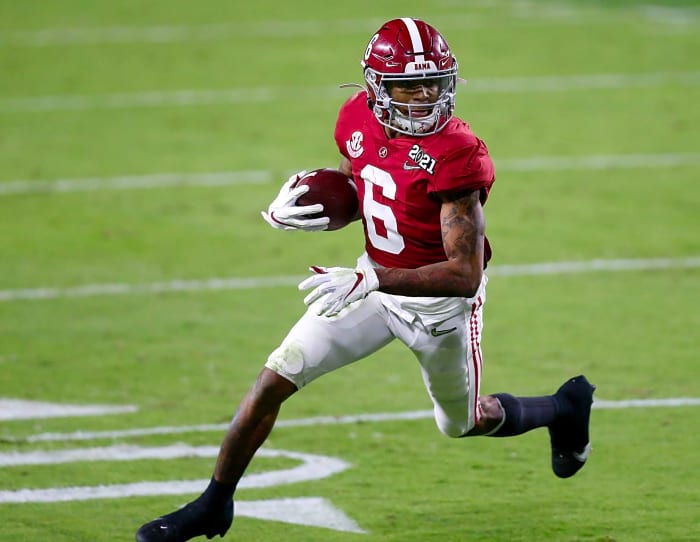
Smith's freshman season at Alabama will be forever known for one play -- his 41-yard touchdown reception from Tua Tagovailoa in overtime to beat Georgia in the College Football Playoff championship game. That was his only catch in that game and just the 8th of the season.
He improved a bit as a sophomore and took a huge jump as a junior. His senior season, however, was special. He caught 117 passes for 1,856 yards and 23 touchdowns in Alabama's national championship season -- Smith's second title. That season saw him have at least 11 receptions five times, 100 receiving yards 9 times, 150 yards 7 times, and 200 yards 3 times. He also had at least three TD grabs in four games that season. In the national championship game against Ohio State, Smith caught 12 passes for 215 yards and 3 touchdowns.
Terrell Suggs, DE, Arizona State

"T-Sizzle" was a monster. During his three years with the Sun Devils, he set the school record for career tackles for loss (65.5) and career sacks (46). As a junior in 2002, he set the NCAA single-season record with 24 sacks and won the Butkus, Hendricks, Lombardi, Nagurski, Morris, and Bill Willis awards.
Ndamukong Suh, DT, Nebraska

Ndamukong Suh was one of the best defensive lineman of the 21st century and could have been the first defense-only player to win the Heisman Trophy. His 2009 season was absolutely dominating, and while he didn't win the Heisman he did win virtually every other award a defensive lineman could win. In the 2009 Big 12 championship game against Texas, he had 12 total tackles (10 solo), 6 tackles for loss, and 4.5 sacks in a 13-12 controversial loss to the Longhorns. He even managed four interceptions in his college career.
Jonathan Taylor, RB, Wisconsin

How spectacular was Jonathan Taylor during his three years at Wisconsin?
Freshman: 1,977 rush yards, 13 TDs
Sophomore: 2,194 rush yards, 16 TDs
Junior: 2,003 rush yards, 26 total TDs
His 6,174 rushing yards are 4th all-time in FBS history (6th when adding everyone's bowl results) and he is the only player in the top 14 on that list to not play at least four seasons. He won the Doak Walker award twice, three-time All-Big Ten and twice was a unanimous first team All-American. Unreal.
Tim Tebow, QB, Florida

You can argue that Tebow had the greatest career of anyone on this list. He won two national championships, a Heisman Trophy as a sophomore (his first season as a starter), threw for over 9,000 yards, 88 passing TDs, rushed for nearly 3,000 yards and 57 touchdowns. He was also the quintessential leader of a Gators team that, in hindsight, had a lot of characters on the roster.
Vince Young, QB, Texas

Vince Young was a perfect example of a player who saw the light come on during his career and he soared to an unforgettable season. For his first two seasons, he was more of a runner than a passer, but as a junior he became the first player to throw over 3,000 yards and rush for 1,000 yards in a season. That year was a championship season for the Longhorns, who beat USC in one of the greatest college football games of all time. Young completed 30 of his 40 passes for 267 yards, and rushed for 200 yards and three TDs ... two of which came in the final 4:03 of the game to overcome a 12-point deficit to win the Rose Bowl and the BCS championship.
Deshaun Watson, QB, Clemson

Forget what you know about how Watson's life and NFL career have transpired -- Watson was absolutely riveting in college. The Clemson QB not only helped resurrect the Tigers program to national prominence, he stood up to the dynastic Alabama Crimson Tide and came away a champion.
This is how great Watson was: despite losing 45-40 in the national championship game to Alabama in 2015-2016, he puzzled Nick Saban, who was left in awe over the sophomore's performance on the biggest stage. Bama and Clemson would meet in a rematch for the title the following year, with Watson orchestrating the game-winning drive with seconds remaining and toppling the Tide, 35-31.
Those final two seasons of Watson's college career saw Clemson win 28 of their 30 games and Watson throwing for nearly 8,700 yards, 76 touchdowns, and rushing for 1,734 yards and 21 scores.
Shiloh Carder has over 20 years experience in covering sports for various websites and has been with Yardbarker since 2009. A Charlotte, NC native who now lives outside Cincinnati, he has covered college basketball, college football, NFL and NBA. You can find him on Twitter/X at @SportzAssassin
More must-reads:
- Deion Sanders has strong words after Colorado destroyed by Utah
- Missouri's loss to Vanderbilt even more costly with Beau Pribula injury
- The 'ALCS MVPs' quiz
Breaking News
Trending News
Customize Your Newsletter
 +
+
Get the latest news and rumors, customized to your favorite sports and teams. Emailed daily. Always free!
PRIVACY POLICY EDITORIAL POLICY CONTACT US
ABOUT YARDBARKER TERMS OF SERVICE
Use of this website (including any and all parts and
components) constitutes your acceptance of these
Terms of Service and Privacy Policy.
This site is for entertainment purposes only.
There is no gambling offered on this site.
Gambling Problem? Call 1-800-Gambler.


